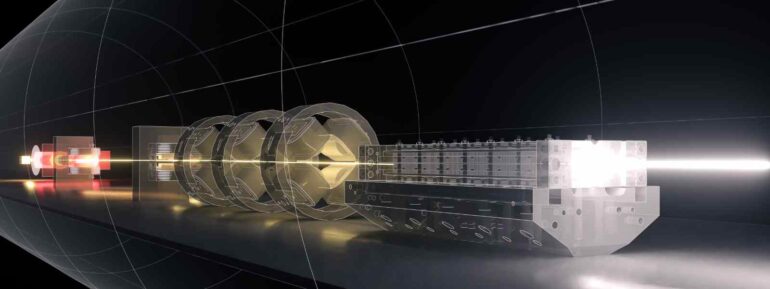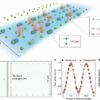Ice-cold electron beams simulated in research at the University of Strathclyde could pave the way to reducing X-ray free-electron lasers (X-FELs) to a fraction of their current size.
X-FELs convert the kinetic energy of an electron beam into powerful photon pulses, down to hard X-ray wavelengths, and are often called ‘engines of discovery.’ X-FELs are used to create extreme matter conditions for hot-dense matter research, to study properties of materials for next-generation microchips, to resolve the structure of complex biomolecules for new medications, and many other applications.
At the heart of FELs are electron beams swinging on a path inside a device, known as an undulator, with an alternating magnetic field. As a result of the wiggling motion, the electron beam emits bursts of photons and a positive feedback effect structures the electron beam into micro-bunches at the radiation wavelength. Consequently, the radiation power grows exponentially along the undulator and becomes highly coherent.
This self-organizing effect can occur only if the electron beam is of high quality at relativistic energies. However, to meet the stringent electron beam quality requirements, state-of-the-art X-FELs are kilometer-scale finely tuned machines, costing as much as a billion-pounds. Consequently, only a handful of X-FEL facilities exist worldwide, with none in the UK so far.
The Strathclyde research shows, with high-fidelity start-to-end simulations, that a Plasma Wakefield Accelerator (PWFA), equipped with a ‘Trojan horse’ advanced electron injection method called plasma photocathode, can produce electron beams 100,000 times brighter than state-of-the-art. This is because of the low momentum spread distribution, producing extremely cold electron beams.
The PWFA also has an accelerating electric field, with a capacity of tens to hundreds of gigavolt-per-meters, which enables the realization of the accelerator on a centimeter scale, compared with the kilometer scales of traditional accelerators.
The study explores how to extract, transport, isolate and inject the ultra-high brightness, ice-cold electron beams from plasma photocathode PWFA into an undulator without charge and quality loss; they remain cold and do not ‘melt.’ Focused into an undulator, the ultrahigh quality electron beam produces powerful coherent, laser-like photon pulses, with pulse durations in the attosecond regime (1×10−18 of a second). In addition to the extreme quality of the electron and resulting photon pulses, the entire system may have a spatial footprint of only few tens of meters, in contrast to state-of-the-art, kilometer-size X-FEL machines.
The scientists working on the study believe that the three milestones achieved in the study could be a gateway to next-generation ultra-compact X-FELs. The study has been published in the journal Nature Communications and forms part of the nationwide UK X-FEL project.
Fahim Habib, a Research Associate in Strathclyde’s Department of Physics and leading post-doctoral researcher of the study, said, “The prospects of ultra-compact plasma-X-FELs based on this scheme are mind-boggling. Our results are important first milestones, but much more work is ahead of us towards experimental realization of the approach.”
Professor Bernhard Hidding of Strathclyde, who leads the project, said, “The first experimental evidence for plasma photocathode injection in PWFA was obtained in our Trojan Horse collaboration at our strategic partner Stanford’s SLAC FACET facility. Now, with our program at the successor facility SLAC FACET-II, we aim to exploit the true potential of the scheme in terms of beam quality and stability.”
Dr. Brian McNeil, a Reader in the Department of Physics, said, “Brightness is the key performance parameter for free-electron-lasing. If electron beams as bright and short as shown in our computational study can be realized from plasmas, this could have an enormous impact on photon science.”
More information:
A. F. Habib et al, Attosecond-Angstrom free-electron-laser towards the cold beam limit, Nature Communications (2023). DOI: 10.1038/s41467-023-36592-z
Provided by
University of Strathclyde, Glasgow
Citation:
Ice-cold electron beams for ultra-compact X-ray lasers (2023, March 1)



